Students can Download Tamil Nadu 11th Economics Model Question Paper 5 English Medium Pdf, Tamil Nadu 11th Economics Model Question Papers helps you to revise the complete Tamilnadu State Board New Syllabus, helps students complete homework assignments and to score high marks in board exams.
TN State Board 11th Economics Model Question Paper 5 English Medium
General Instructions:
- The question paper comprises of four parts.
- You are to attempt all the parts. An internal choice of questions is provided wherever applicable.
- All questions of Part I, II, III and IV are to be attempted separately.
- Question numbers 1 to 20 in Part I are Multiple Choice Questions of one mark each.
These are to be answered by choosing the most suitable answer from the given four alternatives and writing the option code and the corresponding answer - Question numbers 21 to 30 in Part II are two-mark questions. These are to be answered in about one or two sentences.
- Question numbers 31 to 40 in Part III are three-mark questions. These are to be answered in above three to five short sentences.
- Question numbers 41 to 47 in Part IV are five-mark questions. These are to be answered in detail Draw diagrams wherever necessary.
Time: 3:00 Hours
Maximum Marks: 90
PART – I
Choose the correct answer. Answer all the questions: [20 × 1 = 20]
Question 1.
Marginal revenue is the addition made to the …………………….
(a) Total sales
(b) Total revenue
(c) Total production
(d) Total cost
Answer:
(b) Total revenue
![]()
Question 2.
Function with single independent variable is known as ………………………
(a) Multivariate Function
(b) Bivariate Function
(c) Univariate Function
(d) Polynomial Function
Answer:
(c) Univariate Function
Question 3.
There is no opportunity cost in ……………………..
(a) Floating cost
(b) Prime cost
(c) Sunk cost
(d) social cost
Answer:
(c) Sunk cost
![]()
Question 4.
Density of population is rural areas are ……………………..
(a) Very high
(b) Very low
(c) Moderate
(d) Constant
Answer:
(b) Very low
Question 5.
Amartya Kumara Sen received the Nobel prize in Economics in the year ……………………..
(a) 1998
(b) 2000
(c) 2008
(d) 2010
Answer:
(a) 1998
Question 6.
The transfer of ownership from public sector to private sector is known as ……………………..
(a) Globalization
(b) Liberalization
(c) Privatization
(d) Nationalization
Answer:
(c) Privatization
![]()
Question 7.
The gateway of privatization ………………………..
(a) Denationalization
(b) Disinvestment
(c) Both (a) and (b)
(d) None of these
Answer:
(c) Both (a) and (b)
Question 8.
Equilibrium condition of a firm is …………………….
(a) MC = MR
(b) MC > MR
(c) MC < MR
(d) MR = price
Answer:
(a) MC = MR
Question 9.
The reward given for the use of capital ………………………..
(a) Rent
(b) Wage
(c) Interest
(d) Profit
Answer:
(c) Interest
![]()
Question 10.
SPIC is located in ……………………
(a) Chennai
(b) Madurai
(c) Tuticorin
(d) Pudukkottai
Answer:
(c) Tuticorin
Question 11.
The advocate of democratic socialism was ……………………..
(a) Jawaharlal Nehru
(b) P.C. Mahalanobis
(c) Dr. Rajendra prasad
(d) Indira Gandhi
Answer:
(a) Jawaharlal Nehru
Question 12.
Which is considered as the basic unit for rural areas?
(a) Panchayat
(b) Village
(c) Town
(d) Municipality
Answer:
(b) Village
![]()
Question 13.
The objective of the Industrial policy 1956 was ……………………
(a) Develop heavy Industries
(b) Develop agricultural sector only
(c) Develop private sector only
(d) Develop cottage Industries only
Answer:
(a) Develop heavy Industries
Question 14.
The long – run production function is explained by ………………………
(a) Law of demand
(b) Law of supply
(c) Return to scale
(d) Law of variable proportions
Answer:
(c) Return to scale
![]()
Question 15.
How many commercial banks were nationalised in 1969?
(a) 10
(b) 12
(c) 14
(d) 16
Answer:
(c) 14
Question 16.
Expansion of FDI ……………………
(a) Foreign Private Investment
(b) Foreign Portfolio
(c) Foreign Direct Investment
(d) Forex Private Investment
Answer:
(c) Foreign Direct Investment
Question 17.
Thiruvalluvar Economic ideas mainly dealt with ………………………..
(a) Wealth
(b) Poverty is the curse in the society
(c) Agriculture
(d) All the above
Answer:
(d) All the above
![]()
Question 18.
State of rest is a point termed as ………………………….
(a) Equilibrium
(b) Non – Equilibrium
(c) Minimum Point
(d) Maximum Point
Answer:
(a) Equilibrium
Question 19.
An incremental change independent variable with respect to change independent variable is known as ………………………….
(a) Slope
(b) Intercept
(c) Variant
(d) Constant
Answer:
(a) Slope
![]()
Question 20.
In sex ratio, Tamil Nadu ranks ……………………..
(a) First
(b) Second
(c) Third
(d) Fourth
Answer:
(c) Third
PART – II
Answer any seven question in which Question No. 30 is compulsory. [7 × 2 = 14]
Question 21.
Define Micro industry?
Answer:
- Micro, small and medium Enterprises are MSMEs produce a wide variety of products in almost all sectors.
- The prominent among them are the engineering, electrical, chemicals, plastics, steel, paper, matches, textiles, hosiery and garments sector.
![]()
Question 22.
Find the average cost function where TC = 60 + 10x + 15x2
Answer:
- Formula = \(\frac{TC}{x}\)
- Average cost function = \(\frac{60}{x}\) + \(\frac{10x}{x}\) + \(\frac { 15x^{ 2 } }{ x } \)
- Average cost = \(\frac{60}{x}\) + 10 + 15x
Question 23.
What is the formula for elasticity of supply if you know the supply function?
Answer:
Elasticity of supply = \(\frac{dq}{dp}\)

![]()
Question 24.
Define Marginal product of a factor?
Answer:
It is the addition or the increment made to the total product when one more unit of the variable input is employed . In other words, it is the ratio of the change in the total product to the change in the units of the input. It is expressed as
Where, MP = ∆TP/∆N
Where, MP = Marginal Product
∆TP = Change in total product
∆N = Change in units of input
It is also expressed as
MP = TP[n] – TP [n – 1]
MP = Marginal product
TP [n] = Total product of employing nth unit of a factor.
TP [n – 1] = Total product of employing the previous unit of a factor, that is, [n – 1]th unit of a factor.
Question 25.
Define Rural economy?
Answer:
- Rural Economics deals with the application of economic principles in understanding and developing rural areas.
- Rural areas are geographical areas located outside towns and cities.
- Rural Economy refers to villages and rural community refers to people living in villages.
![]()
Question 26.
What are goods?
Answer:
Goods are also called:
- Products
- Commodities
- Things
- In Economics, the term ‘goods’ implies the term ‘services’.
Question 27.
Mention the types of distribution?
Answer:
Personal Distribution:
Personal Distribution is the distribution of national income among the individuals.
Functional Distribution:
Functional Distribution means the distribution of income among the four factors of production namely land, labour, capital and organization for their services in production process.
![]()
Question 28.
State the features that distinguish a land tenure system from other system?
Answer:
(I) Land Tenure refers to the system of land ownership and management.
(II) The features that distinguish a land tenure system from the others relate to the following:
- Who owns the land;
- Who cultivate the land;
- Who is responsible for paying the land revenue to the government.
(III) Based on these questions, three different types of land tenure existed in India before Independence.
Question 29.
What is meant by Sunk cost?
Answer:
A cost incurred in the past and cannot be recovered in future is called as Sunk Cost. This is historical but irrelevant for future business decisions. It is called as sunk because; they are unalterable, unrecoverable and if once invested it should be treated as drowned or disappeared.
![]()
Question 30.
Point out the essential features of pure competition?
Answer:
- Large number of Buyers and sellers.
- Homogeneous Product and Uniform price.
- Free Entry and exit.
- Absence of Transport cost.
- Perfect mobility of factors of production.
- Perfect knowledge of the market.
- No Government Intervention.
PART – III
Answer any seven question in which Question No. 40 is compulsory. [7 × 3 = 21]
Question 31.
Compare productivity of any two food crops between Tamil Nadu and India?
Answer:
Productivity position of Tamil Nadu and India:
- The Government of Tamil Nadu lays emphasis on agricultural production and productivity.
- Tamil Nadu tops in productivity, in food crops as well as non – food crops among the states in India.
Productivity position of Tamil Nadu in India
- Tamil Nadu ranks first in maize, cumbu, groundnut, oil seeds and cotton.
- Tamil Nadu ranks second in rice and coconut.
- Tamil Nadu ranks third in sugarcane, sunflower and Jowar.
![]()
Question 32.
How do you justify the merits of privatization?
Answer:
- Privatisation is transfer of ownership and management of enterprises from public sector to private sector.
- Denationalization, disinvestment and opening exclusive public sector enterprises to private sector are the gateways to privatization.
Question 33.
State and explain the elasticity of supply?
Answer:
- Elasticity of supply may be defined as the degree of responsiveness of change in supply to change in price on the part of sellers.
- It is Mathematically expressed as,
Elasticity of supply = Proportionate change in supply/Proportionate change in price
es = \(\frac { \Delta Q_{ S } }{ Q_{ S } } \)/\(\frac { \Delta P }{ P } \)
es = \(\frac { \Delta Q_{ S } }{ \Delta P } \) × \(\frac{P}{Qs}\)
Where Qs represents the supply, P presents price, ∆ denotes a change.
![]()
Question 34.
What are the functions of Entrepreneur?
Answer:
Functions of an Entrepreneur:
1. Initiation:
An organizer is the initiator of the business, by considering the situation and availability of resources and planning the entire process of business of production.
2. Innovation:
A successful entrepreneur is always an innovator. He introduces new methods in the production process.
3. Co – ordination:
An organizer applies a particular combination of the factor of production, to start and run the business or production.
4. Control, Direction and Supervision:
An organiser controls so that nothing prevents the organisation from achieving its goal. He directs the factors to get better results and supeiVises for the efficient functioning of all the factors involved in the process of production.
5. Risk – taking and uncertainty – bearing:
There are risk – taking and uncertainty-bearing obstacles. Risks may be insured but uncertainties cannot be insured. They reduce the profit.
![]()
Question 35.
List out the kinds of wages?
Answer:
Wages are divided into four types.
1. Nominal Wages or Money Wages:
Nominal wages are referred to the wages paid in terms of money.
2. Real Wages:
Real wages are the wages paid in terms of goods and services. Hence, real wages are the purchasing power of money wages.
3. Piece Wages:
Wages that are paid on the basis of quantum of work done.
4. Time Wages:
Wages that are paid on the basis of the amount of time that the worker works.
![]()
Question 36.
Give short note on Cold Storage?
- India is the largest producer of fruits and second largest producer of vegetables in the world.
- Inspite of that per capita availability of fruits and vegetables is quite low because of post – harvest losses which account for about 25% to 30% of production.
- Besides, quality of a sizable quantity of produce also deteriorates by the time it reaches the consumer.
- Most of the problems relating to the marketing of fruits and vegetables can be traced to their perishability.
- Perishability is responsible for high marketing costs, market gluts, price fluctuations and other similar problems.
- In order to overcome this constraint, the Government of India and the Ministry of Agriculture promulgated an order known as “cold storage order, 1964” under section 3 of the Essential Commodities Act., 1955.
Question 37.
Compare positive economics and normative economics?
Answer:
|
Positive Economics |
Normative Economics |
| 1. An increase in money supply implies a price – rise is an economy. | 1. Inflation is better than deflation. |
| 2. As the irrigation facilities and application of chemical fertilizers expand, the production of food grains increases. | 2. More production of luxury goods is not good for a less developed country. |
| 3. An increase in the birth rate and a decrease in the death rate reflect the rate of growth of population. | Inequalities in the distribution of wealth and incomes should be reduced. |
![]()
Question 38.
Describe the development of textile Industry in Tamil Nadu?
Answer:
- Tamil Nadu is the largest textile hub of India.
- Tamil Nadu is known as the “Yam Bowl” of the country accounting for 41% of India’s cotton yam production.
- The textile industry plays a significant role in the Indian economy by providing direct employment to an estimated 35 million people, and thereby contributing 4% of GDP and 35% of gross export earnings.
- The textile sector contributes to 14% of the manufacturing sector.
- From spinning to garment manufacturing, entire textile production chain facilities are in Tamil Nadu.
- About half of India’s total spinning mill capacity is in Tamil Nadu.
- The western part of Tamil Nadu comprising Coimbatore, Tirupur, Erode, Dindigul and Karur has the majority of spinning mills manufacturing cotton, polyester, blended yam and silk yam used by garment units in Tamil Nadu, Maharastra etc.,
- Yam is also exported to China, Bangladesh, etc.,
- Tirupur known as “knitting city” is the exporter of garments worth USD (United States Dollar) 3 billion.
- Karur is the major home for textile manufacturing (curtain cloth, bed linens, kitchen linens, toilet linens, table linens, wall hangings etc.,) and export hub in India.
- Erode is the main cloth market in South India for both retail and wholesale ready – mades.
![]()
Question 39.
What are the important features of utility?
Answer:
The important features of utility are:
- Utility is psychological. It depends on the consumer’s mental attitude. For example, a vegetarian derives no utility from mutton.
- Utility is not equivalent to usefulness. For example, a smoker derives utility from a cigarette; but, his health gets affected.
- Utility is not the same a pleasure. A sick person derives utility from taking a medicine, but definitely it is not providing pleasure.
- Utility is personal and relative. An individual obtains varied utility from one and the same good in different situations and places.
- Utility is the function of the intensity of human want. An individual consumer faces a tendency of diminishing utility.
- Utility cannot be measured objectively. It is a subjective concept and it cannot be measured numerically.
- Utility has no ethical or moral significance. For example, a cook derives utility from a knife using which he cuts some vegetables, and a killer wants to stab his enemy by that knife. In economics, a commodity has utility if it satisfies a human want.
![]()
Question 40.
Mention the features of SHGs?
Answer:
Major features of SHGs [Self Help Groups]
- SHG is generally an economically homogeneous group formed through a process of self – selection based upon the affinity of its members.
- Most SHGs are women’s groups with membership ranging between 10 and 20.
- SHGs have well – defined rules and by – laws, hold regular meetings and maintain records and savings and credit discipline.
- SHGs are self managed institutions characterized by participatory and collective decision making.
PART- IV
Answer all the questions. [7 × 5 = 35]
Question 41 (a).
A firm has the revenue function R = 600q – 0.03q2 and the cost function is
C = 150q + 60,000, where q is the number of units produced. Find AR, AC, MR and MC?
Answer:
(I) Average Revenue = \(\frac{R}{q}\)
\(\frac { 600q-0.03q^{ 2 } }{ q } \) = \(\frac{600q}{q}\) – \(\frac { 0.03q^{ 2 } }{ q } \)
AR = 600 – 0.03q
(II) Average Cost = \(\frac{C}{q}\)
= \(\frac{150q+60000}{q}\)
= \(\frac{150q}{q}\) + \(\frac{60000}{q}\)
AC = 150 + \(\frac{60000}{q}\)
(III) Marginal Revenue = \(\frac{dR}{dq}\)
R = 600q – 0.03q2
\(\frac{dR}{dq}\) = 600 – (0.03)q2
\(\frac{dR}{dq}\) = 600 – (0.03)(2q)
MR = 600 – 0.06q
(IV) Marginal Cost = \(\frac{dC}{dq}\)
C = 150q + 60000
MC = 50
[OR]
(b) What are the steps involved in executing a MS Excel sheet?
Answer:
- MS – excel is used in data analysis bý using formula.
- A spread sheet is a large sheet of paper which contains rows and columns.
- The intersection of rows and columns is termed as cell.
- MS – Excel 2007 version supports upto I million rows and 16 thousand columns per work sheet.
MS Excel Start From Various Options:
- Click Start → Program → Micro Soft Excel
- Double click the MS Excel Icon from thè Desktop
Worksheet:
MS – Excel work sheet is a table like document containing rows and columns with data and formula.
There are four kinds of calculation operators. They are:
- Arithmetic
- Comparison
- Text Concatenation [link together]
- Reference
MS – Excel helps to do data analysis and data presentation in the form of graphs, diagrams, area chart, line chart etc.
![]()
Question 42 (a).
Illustrate the concept of producer’s equilibrium?
Answer:
Producer equilibrium implies the situation where producer maximizes his output. It is also known as optimum combination of the factors of production. In short, the producer manufactures a given amount of output with ‘least cost combination of factors’, with his given budget.
Optimum Combination of Factors implies either:
There is output maximisation for given inputs or there is cost minimisation for the given output.
Conditions for Producer Equilibrium:
The two conditions that are to be fulfilled for the attainment of producer equilibrium are:
The iso – cost line must be tangent to iso – quant curve. At point of tangency, the iso-quant curve must be convex to the origin or MRTSLk must be declining.
[OR]
(b) State the relationship between AC and MC?
Answer:
There is a unique relationship between the AC and MC curves as shown in diagram.
- When AC is falling, MC lies below AC.
- When AC becomes constant, MC also becomes equal to it.
- When AC starts increasing, MC lies above the AC.
- MC curve always cuts AC at its minimum point from below.
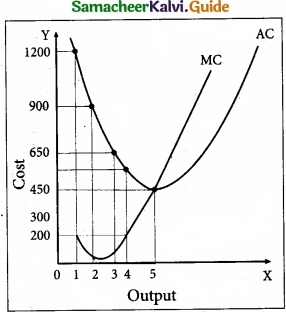
![]()
Question 43 (a).
Explain various divisions of Economics?
Answer:
Economics sub divisions are:
(I) Consumption:
- Human wants coming under consumption is the starting point of economic activity.
- In this section the characteristics of human wants based on the behaviour of the consumer, the diminishing marginal utility and consumer’s surplus are dealt with.
(II) Production:
- Production is the process of transformation of inputs into output.
- This division covers the characteristics and role of the factors of production namely land, labour, capital and organization.
(III) Exchange:
- Exchange is concerned with price determination in different market forms.
- This division covers trade and commerce.
- Consumption is possible only if the produced commodity is placed in the hands of the consumer.
(IV) Distribution:
- Production is the result of the coordination of factors of production.
- Since a commodity is produced with the efforts of land, labour, capital and organization, the produced wealth has to be distributed among the cooperating factors.
- The reward for factors of production is studied in this division under rent, wages, interest and profit.
- Distribution studies about the pricing of factors of production.
[OR]
(b) Explain the law of demand and its exceptions?
Answer:
Definitions:
The Law of Demand says as “the quantity demanded increases with a fall in price and diminishes with a rise in price”. – Marshall
“The Law of Demand states that people will buy more at lower price and buy less at ‘ higher prices, other things remaining the same”. – Samuelson
Assumptions of Law of Demand:
- The income of the consumer remains constant.
- The taste, habit and preference of the consumer remain the same.
- The prices of other related goods should not change.
- There should be no substitutes for the commodity in study.
- The demand for the commodity must be continuous.
- There should not be any change in the quality of the commodity.
Given these assumptions, the law of demand operates. If there is change even in one of these assumptions, the law will not operate.
Explanation:
The law of demand explains the relationship between the price of a commodity and the quantity demanded of it. This law states that quantity demanded of a commodity expands with a fall in price and contracts with a rise in price.
In other words, a rise in price of a commodity is followed by a contraction demand and a fall in price is followed by extension in demand. Therefore, the law of demand states that there is an inverse relationship between the price and the quantity demanded of a commodity.
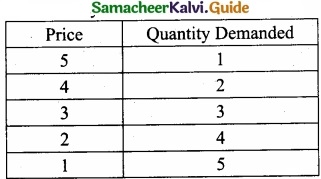
Exceptions to the law of demand:
Normally, the demand curve slopes downwards from left to right. But there are some unusual demand curves which do not obey the law and the reverse occurs. A fall in price brings about a contraction of demand and a rise in price results in an extension of demand. Therefore the demand curve slopes upwards from left to right.
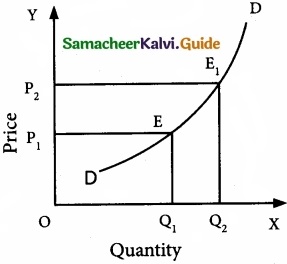
It is known as exceptional demand curve. In the above diagram, DD is the demand curve which slopes upwards from left to right. It shows that when price is OP1, OQ1, is the demand and when the price rises to OP2, demand also extends to OQ2.
![]()
Question 44 (a).
How price and output are determined under the perfect competition?
Answer:
Perfect Competition: Firm’s Equilibrium in the Short Run
In the short run, at least a few factors of production are fixed. The firms under Perfect Competition take the price (10) from the industry and start adjusting their quantities produced. For example Qd = 100 – 5P and Qs = 5P.
At equilibrium Qd = Qs
Therefore 100 – 5P = 5P
100 = 10P; 100/10 = P; Qd = demand
P = 10; P = Price
Qd = 100 – 5(10); Qs = Supply
100 – 50 = 50
Qs = 5 (10) = 50
Therefore 50 = 50
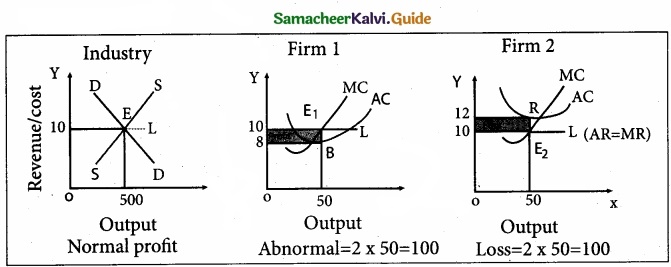
This diagram consists of three panels. The equilibrium of an industry is explained in the first panel. The demand and supply forces of all the firms interact and the price is fixed as 10. The equilibrium of an industry is obtained at 50 units of output.
In the second part of the diagram, AC curve is lower than the price line. The equilibrium condition is achieved where MC = MR. Its equilibrium quantity sold is 50. With the prevailing price, ₹ 10 it experiences super normal profit. AC = ₹ 8, AR = ₹ 10.
Its total revenue is 50 × 10 = 500. Its total cost is 50 × 8 = 400. Therefore, its total profit is 500 – 400 = 100.
In the third part of the diagram, firm’s cost curve is above the price line. The equilibrium condition is achieved at point where MR = MC. Its quantity sold is 50. With the prevailing price, it experiences loss. (AC > AR). Its total revenue is 50 × 10 = 500. Its total cost is 50 × 12 = 600. Therefore, its total loss is 600 – 500 = 100.
As profit prevails in the market, new firms will enter the industry, thus increasing the supply of the product. This means a decline in the price of the product and increase the cost of production. Thus, the abnormal profit will be wiped out; loss will be incurved. When loss prevails in the market, the existing loss making firms will exit the industry, thus decreasing the supply of the product.
This means a rise in the price of the product and reduction in the cost of production. So the loss will vanish; Profit will emerge. Consequent upon the entry and exit of new firms into the industry, firms always earn ‘normal profit’ in the long run as shown in diagram.
[OR]
(b) Elucidate the Loanable funds Theory of Interest?
Answer:
- The Loanable Funds Theory, also known as the “Neo – Classical Theory,” was developed by Swedish economists like Wicksell, Bertil, Ohlin, Viner, Gunnar Myrdal and others.
- According to this theory, interest is the price paid for the use of loanable funds.
- The rate of interest is determined by the equilibrium between demand for and supply of ‘ loanable funds in the credit market.
Demand for loanable funds
The demand for loanable funds depends upon the following:
(I) Demand for Investment [I]
- The most important factor responsible for the loanable funds is the demand for investment.
- Bulk of the demand for loanable funds comes from business firms which borrow money for purchasing capital goods.
(II) Demand for consumption [C]
The demand for loanable funds comes from individuals who borrow money for consumption purposes also.
(III) Demand for Hoarding [H]
- The next demand for loanable funds comes from hoarders. Demand for hoarding money arises because of people’s preference for liquidity, idle cash balances and so on.
- The demand for C, I and H varies inversely with interest rate.
Supply of Loanable funds:
The supply of loanable funds depends upon the following four sources:
1. Savings [S]:
Loanable funds comes from savings. According to this theory, savings may be of two types, namely,
- Savings planned by individuals are called “ex-ante-savings ”.
- The unplanned savings are called ‘ex-post savings”.
2. Bank Credit [BC]:
The bank credit is another source of loanable funds. Commercial banks create credit and supply loanable funds to the investors.
3. Dishoarding [DH]:
Dishoarding means bringing out the hoarded money into use and thus it constitutes a source of supply of loanable funds.
4. Disinvestment: [DI]:
Disinvestment is the opposite of investment. Disinvestment means not providing sufficient funds for depreciation of equipment.
It gives rise to the supply of loanable funds. All the four sources of supply of loanable funds vary directly with the interest rate.
![]()
Question 45 (a).
The features of Rural Economy are peculiar’Argue?
Answer:
Features of Rural Economy:
(I) Village is an Institution:
The village is a Primary Institution and it satisfies almost all the needs of the rural community. The rural people have a feeling of belongingness and a sense of unity towards each other.
Dependence on Agriculture:
The rural economy depends much on nature and agricultural activities. Agriculture and allied activities are the main occupation in rural areas.
Life of Rural people:
Lifestyles in villages are very simple. Public services like education, housing, health and sanitation, transport and communication, banking, roads and markets are limited and unavailable.
The standards of living of majority of rural people are poor and pitiable. In terms of methods of production, social organization and political mobilization, rural sector is extremely backward and weak.
Population Density:
Population density, measured by number of persons living per sq.km is very low and houses are scattered in the entire villages.
Employment:
There exists unemployment, seasonal unemployment and under employment in rural areas.
Poverty:
Poverty is a condition where the basic needs of the people like food, clothing and shelter are not being met.
Indebtedness:
People in rural areas are highly indebted owing to poverty and underemployment, lack of farm and non – farm employment opportunities, low wage employment, seasonality in production, poor marketing network etc.
Rural Income:
The Income of the rural people is constrained as the rural economy is not sufficiently vibrant to provide them.
Dependency:
Rural households are largely dependent on social grants and remittances from family members working in urban areas and cities.
Dualism:
Dualism means the co-existence of two extremely different features like developed and under developed. These characteristics are very common in rural areas. Inequality: The distributions of income, wealth and assets are highly skewed among rural people. Land, livestock and other assets are owned by a few people.
Migration:
Rural people are forced to migrate from villages to urban areas in order to seek gainful employment for their livelihood.
[OR]
(b) Explain the various sources of energy in Tamil Nadu?
Answer:
Tamil Nadu tops in power generation among the Southern States as seen in the table. Tamil Nadu 26,865 MW in 1st Rank in the energy level. Tamil Nadu is in the forefront of all other Indian States in installed capacity.
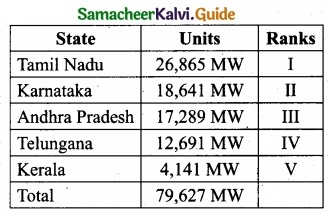
Muppandal wind farm is a renewable energy source, supplying the villagers with electricity for work. Wind farms were built in Nagercoil and Tuticorin apart from already existing ones around Coimbatore, Pollachi, Dharapuram and Udumalaipettai. These areas generate about half of India’s 2,000 megawatts of wind energy or two percent of the total power output of India.
Nuclear Energy:
The Kalpakkam Nuclear Power Plant and the Koodankulam Nuclear Power Plant are the major nuclear energy plants for the energy grid.
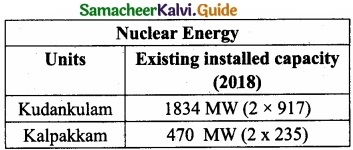
Thermal power:
- In Tamil Nadu the share of thermal power in total energy sources is very high and the thermal power plants are at Athippattu (North Chennai) Ennore, Mettur, Neyveli and Thoothukudi.
- The generation of power under various sources is given here.
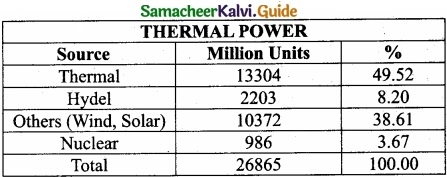
Hydel Energy:
- There are about 20 hydro-electric units in Tamil Nadu.
- The prominent units are Hundah, Mettur, Periyar, Maravakandy, Parson Valley etc.,
Solar Energy:
- Tamil Nadu tops in solar power generation in India as seen in the table here:
- Southern Tamil Nadu is considered as pne of the most suitable regions in the country for developing solar power projects.
Wind Energy:
- Tamil Nadu has the highest installed wind energy capacity in India.
- The State has very high quality of offshore wind energy potential off the Tirunelveli coast and southern Thoothukudi and Rameswaram coast.
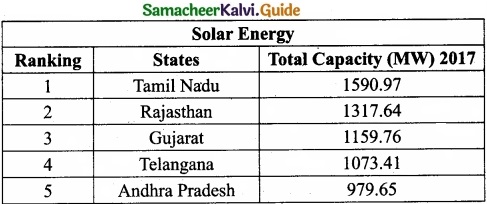
![]()
Question 46 (a).
What are the methods of measuring Elasticity of demand?
Answer:
There are three methods of measuring price elasticity of demand.
1. The Percentage method:
ep = \(\frac { \Delta Q }{ \Delta P } \), \(\frac{P}{Q}\)
It is also known as ratio method, when we measure the ratio as:
ep = \(\frac { %\Delta Q }{ %\Delta P } \) where,
% ∆Q = Percentage change in demand
% ∆P = Percentage change in price
2. Total Outlay Method:
Marshall suggested that the simplest way to decide whether demand is elastic or inelastic is to examine the change in total outlay of the consumer or total revenue of the firm Total Revenue = (Price × Quantity Sold)
TR = ( P × Q)

Where there is inverse relation between Price and Total Outlay, demand is elastic. Direct relation means inelastic. Elasticity is unity when Total Outlay is constant.
3. Point or Geometrical Elasticity:
When the demand curve is a straight line, it is said to be linear. Graphically, the point elasticity of a linear demand curve is shown by the ratio of the segments of the line to the right and to the left of the particular point.
Lower segment of the demand curve
Point Elasticity = 
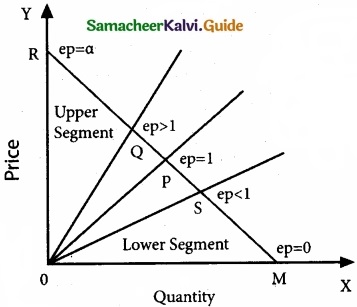
ep = \(\frac{L}{U}\)
Where ‘ep’ stands for point elasticity, ‘L’ stands for the lower segment and ‘U’ for the upper segment.
[OR]
(b) Explain the VKRV Rao’s National Income Methodology and Industrialization?
Answer:
(a) Rao’s National Income Methodology:
- Rao’s name is remembered for his pioneering work on the enumeration of national income of India.
- He attempted
- To develop the national income concepts suited to India and developing countries.
- To analyze the concepts of investment, saving and the multipliers is an underdeveloped economy.
- To study the compatibility of the national incomes of Industrialized and underdeveloped countries.
- Rao’s paper on “Full Employment and Economic Development” was one of the earliest contributions in the field of development towards employment.
(b) Rao’s views on Industrialization:
Rao gave the following reasons for low per capita income and low levels of per capita nutrition in India.
- Uneconomic holdings with sub-divisions and fragmentation.
- Low levels of water availability for crops.
- Excess population pressure on agriculture due to the absence of a large industrial sector.
- Absence of capital.
- Absence of autonomy in currency policy, and in general in monetary matters encouraging holding of gold.
![]()
Question 47 (a).
Compare and contrast various definitions of economics?
Answer:
1. Adam Smith’s wealth definition:
- Adam Smith [1723 – 1790] in his book “An Inquiry into Nature and Cause of Wealth of Nations” [1776] defines “Economics as the science of wealth”
- He explains how a nation’s wealth is created and increased.
- He considers that the individual in the society wants to promote his own gain and in this process, he is guided and led by an “invisible hand”
- Adam Smith favours the introduction of “division of labour” to increase the quantum of output.
- Severe competition in factories and society helps in bettering the product.
- Supply force is very active and a commodity is made available to the consumers at the lowest price.
2. Alfred Marshall welfare definition: .
- Alfred Marshall [1842-1924] in his book “Principles of Economics” [1890] defines economics thus “Political Economy” or Economics is a study of mankind in the ordinary business of life.
- It examines that part of individual and social action which is most closely connected with the attainment and with the use of the material requisites of well being.
- Thus , it is on one side a study of wealth and on the other and more important side, a part of the study of man”.
The important features of Marshall’s definition are:
- Economics does not treat wealth as’the be-all and end-all of economic activities.
- Man promotes primarily welfare and not wealth.
- The science of economics contains the concerns of ordinary people who are moved by love and not merely guided or directed by the desire to get maximum monetary benefit.
- Economics is a social science. It studies people in the society who influence one another.
3. Lionel Robbins – Scarcity definition:
- Lionel Robbins published a book “An Essay on the Nature and Significance of Economic Science” in 1932.
- According to him, “Economics is a science which studies human behaviour as a relationship between ends and scarce means which have alternative uses”.
The major features of Robbins’ definition:
- Ends refer to human wants, human beings have unlimited number of wants.
- On the other hand, resources or means that go to satisfy the unlimited human wants are limited or scarce in supply.
- The scarce means are capable of having alternative uses.
- An individual grades his wants and satisfies first his most urgent want.
- Economics, according to Robbins, is a science of choice. •
4. Samuelson’s – growth definition:
- Paul Samuelson defines economics as “the study of how men and society choose, with or without the use of money, to employ scarce productive resources which could have alternative uses to produce various. commodities over time, and distribute them for consumption, now and in the future among various people and groups of society”.
The major implications of this definition are as follows: - Samuelson’s makes his definition dynamic by including the element of time in it.
- Samuelson’s definition is applicable also in a barter economy.
- His definition covers various aspects like production, distribution and consumption.
- Samuelson treats economics as a social science.
- Samuelson appears to be the most satisfactory.
[OR]
(b) Explain the law of Equi – marginal utility?
Answer:
The law of the Equi-marginal utility:
- The law of diminishing marginal utility is applicable only to the want of a single commodity.
- The law of equi – marginal utility explains the behavior of a consumer when he consumer more than one commodity.
- Wants are unlimited but the income which is available are limited.
- This law explains how the consumer spends his limited income on various commodities to get maximum satisfaction.
- Law of Equi-Marginal Utility is also known as the law of substitution.
- “The law of consumer’s equilibrium ”
- “Gossen’s second law ” and “ The law of maximum satisfaction”.
Definition:
Marshall states the law as, “If a person has a thing which he can put to several uses, he will distribute it among these uses in such a way that it has the same marginal utility in all. For, if it had a greater marginal utility in one use than another he would gain by taking away some of it from the second use and applying it to first”.
Assumption:
- The consumer is rational in the sense that he wants to get maximum satisfaction.
- The utility of each commodity is measurable in cardinal numbers.
- The marginal utility of money remains constant.
- The income of the consumer is given. ‘
- There is perfect competition in the market.
- The prices of the commodities are given.
- The law of diminishing marginal utility operates.
Illustration:
This law can be illustrated with the help of table. Let us assume that the consumer has a given income of ₹ 11. He wants to spend this entire income [i.e. ₹ 11] on Apple and Orange. The price of an Apple and the price of an orange is ₹ 1 each.
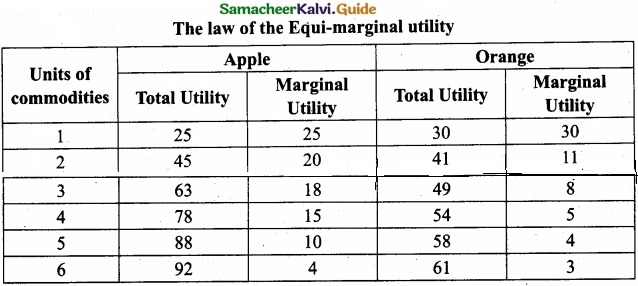
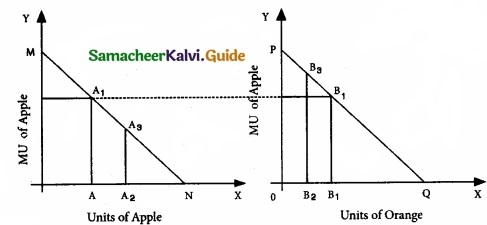
If the consumer wants to attain maximum utility, he should buy 6 units of apples and 5 units of oranges, so that she can get [92 + 58] = 150 units. No other combination of Apple and Orange can give higher than 150 utilities.
Diagrammatic Illustration:
In the diagram, X – axis represents the amount of money spent and Y axis represents the marginal utilities of Apple and Orange respectively.
If the consumer spends ₹ 6 on Apple and ₹ 5 on Orange, the marginal utilities of both are equal, i.e. AA1 = BB1 [4 = 4], Hence, he gets maximum utility.
Criticisms:
- In practice, utility cannot be measured, only be felt.
- This law cannot be applied to durable goods.